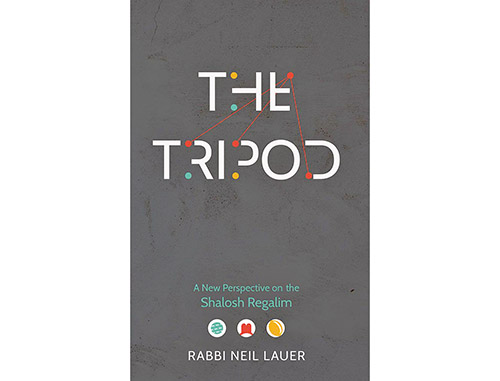
Reviewing: “The Tripod: A New Perspective on the Shalosh Regalim” by Neil Lauer. Mosaica Press. 2022. Hardcover. 324 pages. ISBN-13: 9781957579139.
What a magnificent work brimming with new and creative approaches to the Shalosh Regalim presented in a gentle, welcoming, and creative style! I highly recommend this work as a must-read book, the quality of which appears only once in years. The beginner and advanced scholar will prosper from enjoying every second he reads this book.
There is no better way to capture the power of this wonderful work than Rabbi Lauer’s words in his introduction. He writes:
“Some have a narrower view of the festivals, while others have a more expansive one. The former view religious holiday observances primarily as an expression of a commitment to the Torah and a display of solidarity with the Jewish people. Others view the festivals differently; they enjoy a broader and more nuanced appreciation of the agendas and significance of each holiday. They appreciate the festival’s impact on all aspects of their life. For them, the festivals represent a richer, more fulfilling experience. Those who possess a narrower perspective on the holidays may not be aware that this is the case, and they likely do not know what they are missing. The point of this work is to help foster a broader, richer appreciation of the function, mechanics and message of the festivals by encouraging one to take notice of certain elements that one may have overlooked in the past.”
Rabbi Lauer is a smashing success in achieving his stated goal! He does not overburden with a flood of sources. Instead, the author cites the most important and relevant citations and develops them clearly and elegantly, building them to bring home his central ideas. He gently and slowly develops his ideas, enticing his readers to join him in this great adventure. Readers will find it very difficult to put down this sefer.
Here are samples of Rabbi Lauer’s magnificent thoughts on the upcoming Yom Tov of Sukkot, using his golden words:
“The issue of what the sukkah, and by extension, the festival of Sukkot, commemorates is the subject of a machloket (dispute) in the Gemara. The Gemara cites a dispute over whether the sukkot we are commemorating are the actual huts we lived in, or the ananei hakavod, the clouds that accompanied and protected us throughout our travels in the midbar …The midbar experience — like the events surrounding our leaving Mitzrayim — can be seen as having both a physical and a spiritual dimension. Both elements of our midbar experience contributed to our physical well-being. The sukkot-mamash approach, which takes the sukkah as representing the huts B’nei Yisrael lived in, however, focuses on God’s providing for our physical needs. By contrast, the ananei hakavod approach addresses not only the fact that God took care of our physical needs, but also it highlights a construct that is emblematic of the relationship we had with God at the time and the appreciation of what God had done for us.”
Regarding the arba minim, Rabbi Lauer writes:
The symbolism of the arba minim is not clear, they do not possess an obvious connection to yetziat Mitzrayim or the midbar experience. Their relationship to Sukkot’s role within the agricultural cycle as the beginning of the rainy season, however, does afford one an insight into their function within the Shalosh Regalim.
The four species of vegetation taken on Sukkot each require a different amount of water to function properly. In this way, they serve to represent the varied nature of hashgacha. Divine providence is not one-size-fits-all. Different people enjoy different levels of Divine providence based on their level of their relationship with Hashem.
A unique element of Rabbi Lauer’s sefer is his weaving in references to his daily commute from his Teaneck home to his suspender factory in Brooklyn. Most people view their daily commute as dull and miserable. Not so Rabbi Lauer … He elevates an otherwise difficult and mundane activity into a great opportunity. Rabbi Lauer delightfully surprises his readers at the very start of the book by saying:
“The Sages teach that one should begin one’s remarks by acknowledging one’s hosts, ‘potchim b’kvod achsania (Brachot 63b).’ As such, I want to express my thanks to the Metropolitan Transit Authority and New Jersey Transit for hosting me while composing this volume. In an effort to maintain a productive commute, I wrote this book primarily on the subway and bus, while traveling to and from my suspender factory in Brooklyn, New York. Not coincidentally, mass transit is reflected in some of the analogies used throughout.”
Rabbi Lauer not only succeeds in deepening and enriching our Yom Tov experiences; he also inspires us to aim higher in our Torah lives. The Gemara (Yoma 35b) tells of heroes who overcame substantial challenges and became great masters of the Torah, despite their difficulties. For example, Hillel famously overcame the challenge of poverty, and Rabbi Elazar ben Charsom conquered the challenge of wealth. The Gemara concludes that these great talmidei chachamim obligate the rest of us to become great Torah scholars. After all, if they accomplished so much despite their many demands, everyone else has no excuse for not doing so.
In our generation, Rabbi Lauer is mechayev, obligates all of us. If a busy businessman can compose a very high-quality sefer during his daily commute, what excuse does any one of us have for not spiritually improving ourselves?
You will never celebrate the chagim in the same way, after learning Rabbi Lauer’s “The Tripod.” Therefore, I enthusiastically recommend it as essential Yom Tov reading that will transform and elevate your spiritual life during the holidays and year-round.
Rabbi Haim Jachter is the spiritual leader of Congregation Shaarei Orah, the Sephardic Congregation of Teaneck. He also serves as a rebbe at Torah Academy of Bergen County and a dayan on the Beth Din of Elizabeth.









